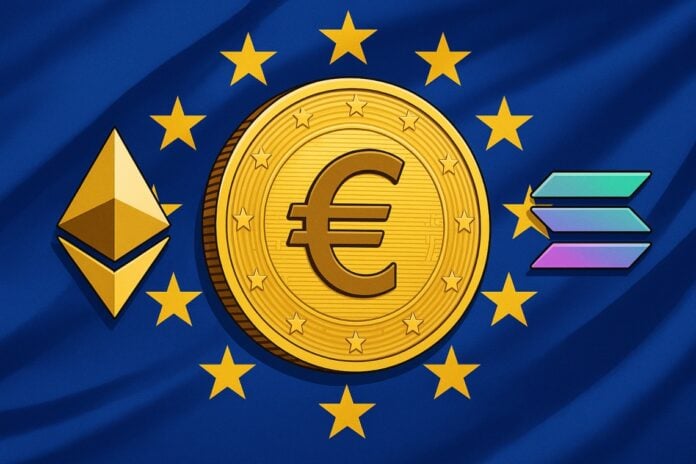The pressure on the digital euro continues to grow: in 2025 the market for stablecoin in dollars is estimated to be around $288 billion (data to be verified Reuters, June 2025).
After the approval of the GENIUS Act – the US law on stablecoin signed by the President in 2025 Cryptonomist –, Brussels and the ECB are accelerating the dossier, also putting on the table the hypothesis of implementations on public blockchains like Ethereum and Solana.
Industry analysts note that political and market urgency has pushed the BCE and national authorities to intensify technical tests and operational impact assessments.
According to data collected from comparative studies between institutions and research centers, over 80% of central banks have initiated forms of exploration or design of CBDC (see report by the Bank for International Settlements, 2021).
The experiments in the preparation phase of the BCE include tests on privacy, scalability, and integration with European instant payments, with results that will be crucial for architectural choices.
Summary
In brief: the 3 key facts
- EU Acceleration: the technical phase of the digital euro is driven by increasing regulatory pressure and international competition.
- Open technological options: public networks (Ethereum, Solana), permissioned platforms, and hybrid solutions are being evaluated.
- Strategic objective: ensure monetary sovereignty, interoperability, and privacy in line with the EU regulatory framework (MiCA and proposals on the digital euro).
What changes for Europe (and why now)
The new U.S. regulation has raised the bar for competition. For this reason, European institutions are intensifying work on the project of CBDC, to prevent the global infrastructure of digital payments from revolving exclusively around the dollar.
In this context, the BCE continues in the preparation phase of the digital euro, experimenting with architectures, privacy-by-design models, and integrations with existing systems; meanwhile, the European Commission refines the regulatory framework for a possible issuance and retail-level use. The preparation is coordinated with impact studies and public consultations to assess effects on financial stability, banking intermediation, and inclusion.
Offices and networks under evaluation
No definitive decision has been made regarding the network or the launch jurisdiction. It should be noted that the options on the table range from using public infrastructures (Ethereum, Solana), to the creation of a permissioned European ledger, up to hybrid configurations that attempt to combine scalability and data protection.
Technological options compared
- Public networks (Ethereum, Solana): offer maximum interoperability and a vast community of development; however, questions remain about governance, node location, and data handling (Ethereum docs, Solana docs).
- Private/permissioned networks: they ensure full operational control, simplified compliance, and more granular privacy; the trade-off is less transparency to the outside and a potential risk of technological lock-in.
- Hybrid architectures: they combine a public layer, to ensure liquidity and interoperability, with a private layer that manages the confidentiality of transactions, integrating certified and auditable bridges.
Centralization vs decentralization: real impacts
- Centralized approach: it favors supervision, reporting, and AML/CFT controls, although it introduces the risk of a single point of failure and lower resilience.
- Decentralized approach: increases transparency and resilience of the network, but requires clear decisions on cross-border governance, scalability, and protection of anonymity.
Advantages and risks of a digital euro on public blockchain
- Advantages: possibility of achieving global interoperability, reducing time to market, and making cross-border payments more efficient, as well as promoting greater composability with regulated DeFi ecosystems.
- Risks: greater exposure to external shocks and dependencies on non-EU infrastructures; need for advanced privacy solutions and adequate anti-money laundering controls; possible tensions with technological sovereignty.
Effect of the USA on European digital payments
The adoption of clear rules in the United States, as highlighted by the recent GENIUS Act Reuters, increases the likelihood that stablecoin in dollari will consolidate liquidity and acceptance network on a global scale.
An interesting aspect is that, in response, the EU is considering measures to avoid a structural dependency on extra-European standards, preserving the international role of the euro.
In this context, the focus is on cross-border interoperability, resilience under market stress conditions, and harmonization of rules on wallets, digital identity, and ownership limits, with the aim of supporting financial stability.
EU Strategies for the Competitiveness of the Digital Euro
- Define European technical standards and promote open APIs to ensure integration with banks and PSPs.
- Activate partnerships with private operators and open source communities to encourage adoption.
- Integrate privacy-by-design solutions, proportionate AML/CFT controls, and independent audits.
- Align the project with the regulatory framework provided by MiCA and the current legislative proposals on the digital euro.
Next steps and timelines
In 2025, the phase of technical experimentation coordinated by the BCE will continue, with tests on scalability, privacy, and integration into SEPA circuits and instant payment systems. Subsequently, there will be impact assessments, standardization of wallets, and definition of the distribution model through supervised intermediaries.
It must be said that the political decision regarding the issuance of the digital euro will remain subject to the outcome of the test phases, the consultation with member states, and the discussions in Parliament and the Council (currently under discussion Agenda Digitale).
Adoption Scenarios
The most likely scenario in the short term involves a hybrid model: use of public layers to ensure interoperability and liquidity, alongside permissioned modules that manage aspects of privacy, usage limits, and anti-abuse tools. In this way, the EU aims to balance innovation, control, and protection of citizens.
Regulatory context and reference sources
- ECB – Digital euro (preparation phase)
- ECB – Report on a digital euro (2020)
- BIS – Research/whitepaper on CBDC
- European Commission – Proposal on the digital euro
- MiCA Regulation (EU 2023/1114)
- Technical documentation: Ethereum, Solana
Note on data and quotes
The value of $288 billion for the stablecoin market is cited by Reuters (June 2025) and requires further confirmation through primary sources and methodological updates. The reference to the “USA stablecoin law” is based on the GENIUS Act (2025); the official documentation can be consulted at the sources mentioned above, along with the ECB and BIS reports cited.




